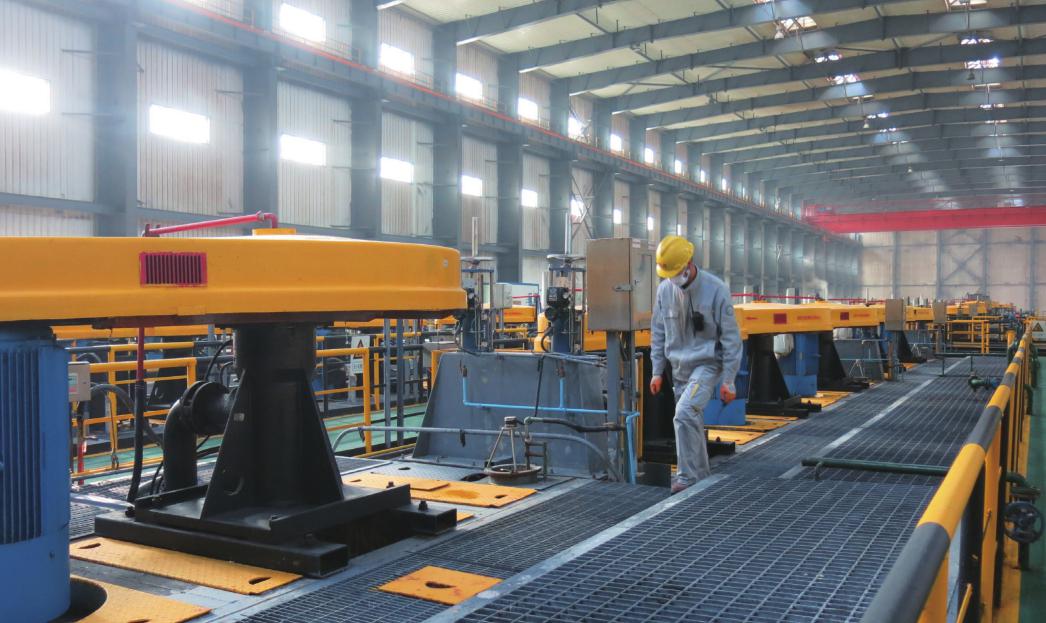On the March
2018-02-17ByZhangShasha
By Zhang Shasha

Since its inception in 2013, the concept of state capital investment and operation companies (SCIOs) has become a crucial aspect of reform of Chinas state-owned enterprises (SOEs) and a signifi cant measure for strengthening state-owned asset supervision with capital management at its core.
Since 2014, the government has selected 10 centrally administered SOEs—eight investment and two operation firms—as the first batch of pilot companies. Local authorities also conducted relevant trials in 122 state-owned companies.
According to statistics from the State-Owned Assets Supervision and Administration Commission of the State Council (SASAC), the total profi t of the 10 companies was 245 billion yuan ($35.5 billion) in 2016, up 45 percent year on year, which surpassed the average of other centrally administered SOEs.
While acquiring tangible benefits, the exploration within these pilot companies has also accelerated the formation of replicable and transferable experience for other SOEs. Peng Huagang, Deputy Secretary of the SASAC, said that SCIOs have tracked out a new model for SOE reform, providing experience in aspects such as strategic management, business development, authorization and organizational adjustment.
In addition, the second batch of pilot companies was selected on November 19, according to the SASAC. “The list will be expanded and powers delegated to these companies will increase,” Hu Chi, a researcher with the SASACs Research Center, told Beijing Review.
Optimizing layout
The mission of SCIOs is to optimize stateowned economic layout and improve the optimal distribution of state-owned capital and its operational effi ciency.
State capital investment companies make investments in line with national strategies and in order to increase their in- dustrial competitiveness, while state capital operation fi rms are mainly tasked with enhancing returns and operational effi ciency, Meng Jianmin, SASACs Vice Chairman, said.
As a representative of a state capital investment company, State Development& Investment Corp. (SDIC) has fully demonstrated the guiding effect of state-owned capital. In 2014, SDIC exited traditional business sectors such as shipping and coal and began to break into strategic emerging industries and hi-tech sectors.
In 2018, traditional industries accounted for less than 50 percent of SDIC business, while the financial sector accounted for 30 percent and new industries such as artificial intelligence, medical equipment, new-energy vehicles, bioengineering and senior healthcare were at 20 percent.
“The most noteworthy feature for investment firms is to optimize industrial structures in time,” Wang Huisheng, SDIC President, said, adding that it is of pivotal importance for such fi rms to know how to invest and sell, as well as when to advance and exit.
With established state-owned funds, China Chengtong Holdings Group Ltd. and China Reform Holdings Corp. Ltd. are the two SCIOs in the first batch of SOEs responsible for financing SOEs structural adjustments, as well as their transformation and upgrading.
Approved by the State Council, Chinas cabinet, and entrusted by the SASAC, China Chengtong established the China Structural Reform Fund Co. Ltd. in 2016, the total scale of which was 350 billion yuan ($50.9 billion), with its fi rst fundraising reaching 131 billion yuan ($19.1 billion). To date, the fund has financed 16 programs, with state-owned programs accounting for 90 percent. Moreover, in the mixed ownership reform of China Unicom—one of the largest state-owned telecommunications operators—the fund invested nearly 13 bil- lion yuan ($1.89 billion).
The launch and implementation of the fund assembles SOEs, fi nancial institutions and social capital together, which provides new fi nancing channels for SOEs to reform.
Zhu Bixin, General Manager of China Chengtong, said the groups next move is to carry out market-oriented equity management and operation, including actively making use of SOEs stock transactions in the Hong Kong Stock Exchange and introducing overseas capital into SOE reform.
Xiao Yaqing, SASAC Chairman, said the government will encourage pilot companies to establish independent financial companies and apply for fi nancial licenses to better serve the real economy by using their own capital.
Hu explained that according to the SASAC, central SOEs can be classifi ed into three categories: industrial groups, investment firms and operation firms. Powers have been entrusted in line with their nature, but sometimes their functions overlap. “The key step for the next stage is to classify central SOEs,” Hu said, adding that on that basis the SASAC can entrust powers accordingly, allowing reform to expand from pilot firms to other SOEs, both central and local ones.
Clarifying relations
The process of advancing reforms of pilot fi rms is also a process of clarifying relations between regulators of state-owned assets and SCIOs, as well as facilitating internal governance of these enterprises.

“SCIOs have become an important link between the government and enterprises to separate government functions from enterprises and the rights of ownership and operation, which is conducive to the marketization of enterprises,” Li Jin, Deputy Director of China Enterprise Reform and Development Society told Beijing Review.“SCIOs have become the focus and breakthrough for SOE reform, behind which is reform of the market system and the system of authorized operation of state capital.”
The SASAC has entrusted 18 items to COFCO Corporation and SDIC, including major business investment, property rights management and salary assessment. It will continue to adjust these items in accordance with the different nature of each company.
Xiao said that through authorizing and delegating powers, boundaries between the SASAC and pilot fi rms become clearer and the status of enterprises as independent market entities are enhanced through independent operation, self-financing, assumption of risks, self-discipline and selfdevelopment.
In addition, the 10 pilot enterprises delegated rights to their contributed companies and encouraged transformation from asset management to capital man- agement at the core.
“Capital management at the core indicates that SASACs supervision over central SOEs has risen to a higher level,” Hu said.“It also means the operation of enterprises has become more marketized and they are getting closer to the capital market. The transformation also boosts the vitality and liquidity of state-owned capital.”
He added that SCIO supervision and their stakeholder relationship with their contributed companies has also changed, leading to good corporate performance.
COFCO has reconstructed the model of group management to realize its transformation. It has established a three-level framework in which headquarters is responsible for the allocation and supervision of state-owned capital, while professional companies help with capital operation and production units execute tasks.
This idea has become a common choice for most of the 10 pilot companies. After the reconstruction of headquarters, functional departments of the SDIC decreased from 14 to nine, with the number of managers decreasing to less than 230. Since the problems of large headquarters and time-consuming approval processes were resolved, rights of management can be delegated to subsidiary companies, which is conducive to infusing vitality and increasing core competitiveness of SOEs.
Li concluded that there are three issues that should be resolved in the next stage. First, the government needs to map out a list of rights to be authorized to SCIOs to clarify rights and obligations, which is at the core. Second, SCIOs should think about how to plan their corporate framework. Third, a mechanism of authorization needs to be put in place.
